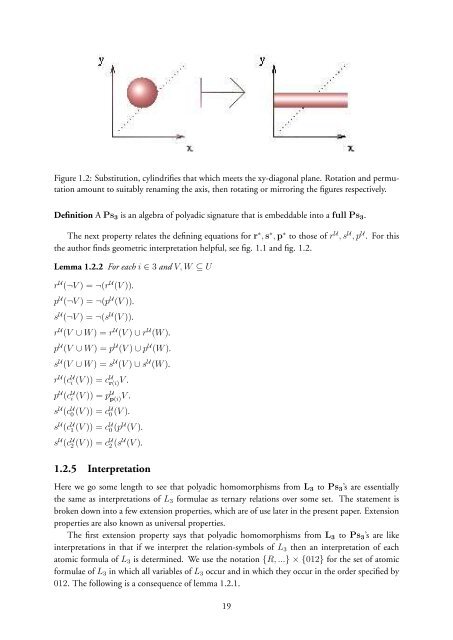On the methods of mechanical non-theorems (latest version)
On the methods of mechanical non-theorems (latest version)
On the methods of mechanical non-theorems (latest version)
Create successful ePaper yourself
Turn your PDF publications into a flip-book with our unique Google optimized e-Paper software.
Figure 1.2: Substitution, cylindrifies that which meets <strong>the</strong> xy-diagonal plane. Rotation and permutation<br />
amount to suitably renaming <strong>the</strong> axis, <strong>the</strong>n rotating or mirroring <strong>the</strong> figures respectively.<br />
Definition A Ps 3 is an algebra <strong>of</strong> polyadic signature that is embeddable into a full Ps 3 .<br />
The next property relates <strong>the</strong> defining equations for r ∗ , s ∗ , p ∗ to those <strong>of</strong> r U , s U , p U . For this<br />
<strong>the</strong> author finds geometric interpretation helpful, see fig. 1.1 and fig. 1.2.<br />
Lemma 1.2.2 For each i ∈ 3 and V, W ⊆ U<br />
r U (¬V ) = ¬(r U (V )).<br />
p U (¬V ) = ¬(p U (V )).<br />
s U (¬V ) = ¬(s U (V )).<br />
r U (V ∪ W ) = r U (V ) ∪ r U (W ).<br />
p U (V ∪ W ) = p U (V ) ∪ p U (W ).<br />
s U (V ∪ W ) = s U (V ) ∪ s U (W ).<br />
r U (c U i (V )) = c U r(i) V .<br />
p U (c U i (V )) = p U p(i) V .<br />
s U (c U 0 (V )) = c U 0 (V ).<br />
s U (c U 1 (V )) = c U 0 (p U (V ).<br />
s U (c U 2 (V )) = c U 2 (s U (V ).<br />
1.2.5 Interpretation<br />
Here we go some length to see that polyadic homomorphisms from L 3 to Ps 3 ’s are essentially<br />
<strong>the</strong> same as interpretations <strong>of</strong> L 3 formulae as ternary relations over some set. The statement is<br />
broken down into a few extension properties, which are <strong>of</strong> use later in <strong>the</strong> present paper. Extension<br />
properties are also known as universal properties.<br />
The first extension property says that polyadic homomorphisms from L 3 to Ps 3 ’s are like<br />
interpretations in that if we interpret <strong>the</strong> relation-symbols <strong>of</strong> L 3 <strong>the</strong>n an interpretation <strong>of</strong> each<br />
atomic formula <strong>of</strong> L 3 is determined. We use <strong>the</strong> notation {R, ...} × {012} for <strong>the</strong> set <strong>of</strong> atomic<br />
formulae <strong>of</strong> L 3 in which all variables <strong>of</strong> L 3 occur and in which <strong>the</strong>y occur in <strong>the</strong> order specified by<br />
012. The following is a consequence <strong>of</strong> lemma 1.2.1.<br />
19
















